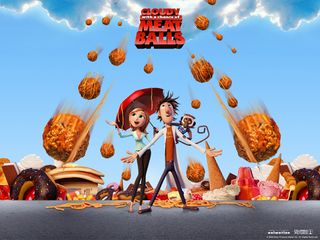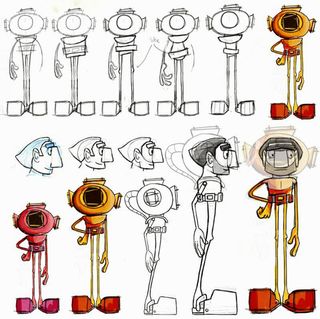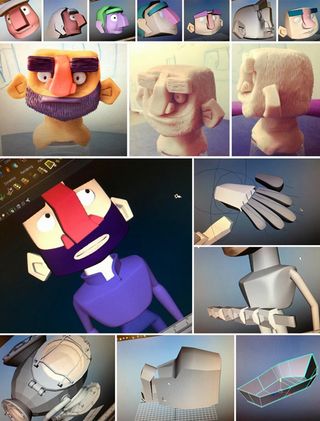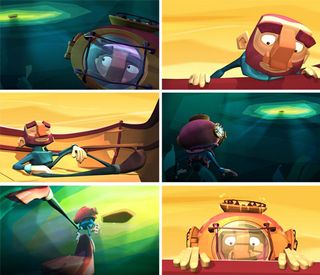Dive deep into stylised 3D student short
Short film The Man Who Saw A Boat was anything but plain sailing, creator Henrique Barone’s reveals...
This gorgeous, stylised short tells the tale of a man living at the bottom of the ocean, who has his tranqulity interrupted by the arrival of a small boat. But should he go and investigate or remain content on the sea bed?
Here we talk to the film's creator Henrique Barone about his inspirations, mixing 2D and 3D animation and overcoming his limited 3D skills...
What were the film’s influences, both story-wise and stylistically?
"I think story-wise the short has more musical than visual influences. Songs like Sound Of Silence by Simon and Garfunkel, Morning Has Broken by Cat Stevens and especially lyrics from Bob Dylan and Johnny Cash influenced the story a lot, even though I noticed that just after I got the idea.
I think story-wise the short has more musical than visual influences
Also, when I was developing the idea for the film I was reading graphic novels by Jeff Lemire, which I admire a lot, especially the story telling aspect of it. I love watching shorts films online, so visual influences are all over. I'd say films from Gobelins are a big one, I like David O'Reilly's films, Salesman Pete and Meet Buck, but I think my favourite one would be Cloudy with Chance of Meatballs. I love the story, the character design and especially the animation."

How long did the animation take to produce?
"The short was produced in the six months of the Digital Character Animation program at Vancouver Film School. The idea of the film started being developed on the very first day; the first four months I worked on character design, modelling and rigging and the last two months were set up for animation (both 2D and 3D) and compositing.
What was the hardest job?
"I'd never touched 3D before this project, so modelling and rigging were the hardest parts for me, especially modeling as I found very hard to translate my graphic style (which works well in paper) to 3D space.
I found very hard to translate my graphic style to 3D space
Also, since the modeling techniques are relatively straight forward it can get quite frustrating when you tweak and tweak and don't get the character looking the way you had drawn or the way you have in your mind.

"Modelling is a mixture of art and technique and rigging is pure technique. Rigging has less experiementation to see how things look, it's more about thinking and solving.
"Rendering was also a challenge, I did get that moment where I thought 'I'll use just Occlusion and that's it!'.

What 3D software did you use and why?
The short was animated in Maya, with the 2D animation created in Flash and the composition in After Effects. I had previous experience producing shorts and 2D animated pieces, but all the aspects of the 3D production were new to me and that was also the first time I was combining techniques.
All the aspects of the 3D production were new to me
This interaction was the part I was worried the most. I had a good visual in my mind but I wasn't sure if I would be able to manage all the technicalities behind it. Because of that I finished the 3D animation earlier than scheduled, leaving two weeks to fine tune the composition and the post 2D animation - water splashes, ripples, sand dust, bubbles, etc - which required the 3D animation to be locked.
What was the most useful piece of software and why?
The only 3D software used in the production was Maya, which I found to be a very powerful tool for producing short films, especially in the animation stage.
What was the most impressive technical aspect of the project and how was it achieved using 3D software?
I'd have to say the lighting and rendering. The sun was the main light source and I used a directional light to simulate that. Fill lights were most of the time spot lights.
Although the light source was the same I wanted to make the two worlds very distinct in light and colors, so I spent a long time experimenting with very hard shadows and saturated colors in the surface of the water and the boat and used almost no shadow and desaturated colors underwater.
I was really pleased that the two light techniques (Maya for character and After Effects for environment) worked well together.

Did you make any mistakes during production?
Although I believe every step was done more than once, the production was actually very smooth. There was a lot of trial and error, which I believe to be one of the best ways to learn something.
What are you working on now?
Right now I'm working as a freelance animator but most of all I'm promoting The Man Who Saw A Boat in animation festivals and also online.
Liked this? Read these!
- Top free 3D models
- Best 3D movies of 2013
- Blender tutorials: ways to create cool effects
Have you seen any inspirational 3D shorts recently? Let us know in the comments!

Thank you for reading 5 articles this month* Join now for unlimited access
Enjoy your first month for just £1 / $1 / €1
*Read 5 free articles per month without a subscription

Join now for unlimited access
Try first month for just £1 / $1 / €1
Get the Creative Bloq Newsletter
Daily design news, reviews, how-tos and more, as picked by the editors.
The Creative Bloq team is made up of a group of design fans, and has changed and evolved since Creative Bloq began back in 2012. The current website team consists of eight full-time members of staff: Editor Georgia Coggan, Deputy Editor Rosie Hilder, Ecommerce Editor Beren Neale, Senior News Editor Daniel Piper, Editor, Digital Art and 3D Ian Dean, Tech Reviews Editor Erlingur Einarsson and Ecommerce Writer Beth Nicholls and Staff Writer Natalie Fear, as well as a roster of freelancers from around the world. The 3D World and ImagineFX magazine teams also pitch in, ensuring that content from 3D World and ImagineFX is represented on Creative Bloq.
